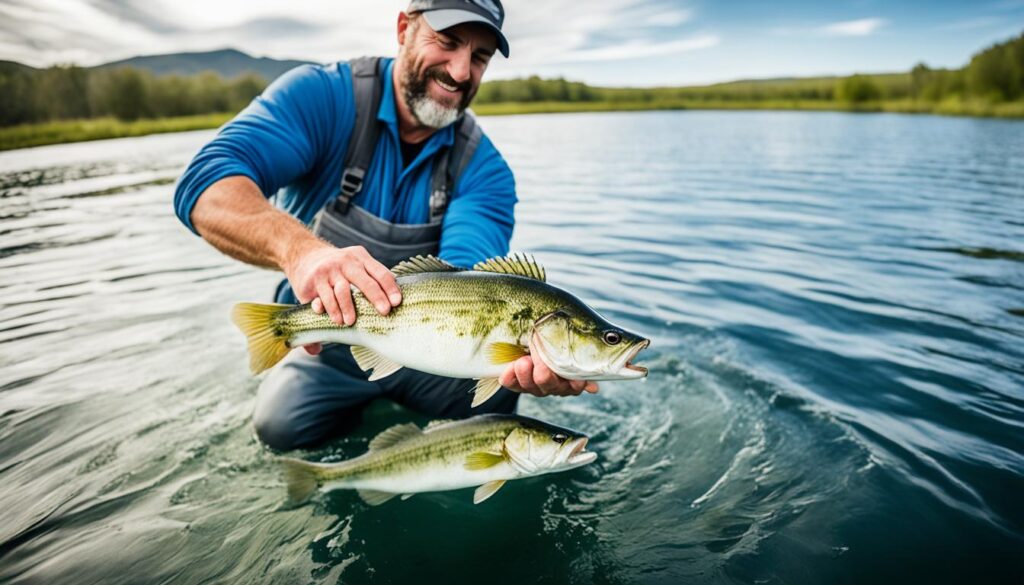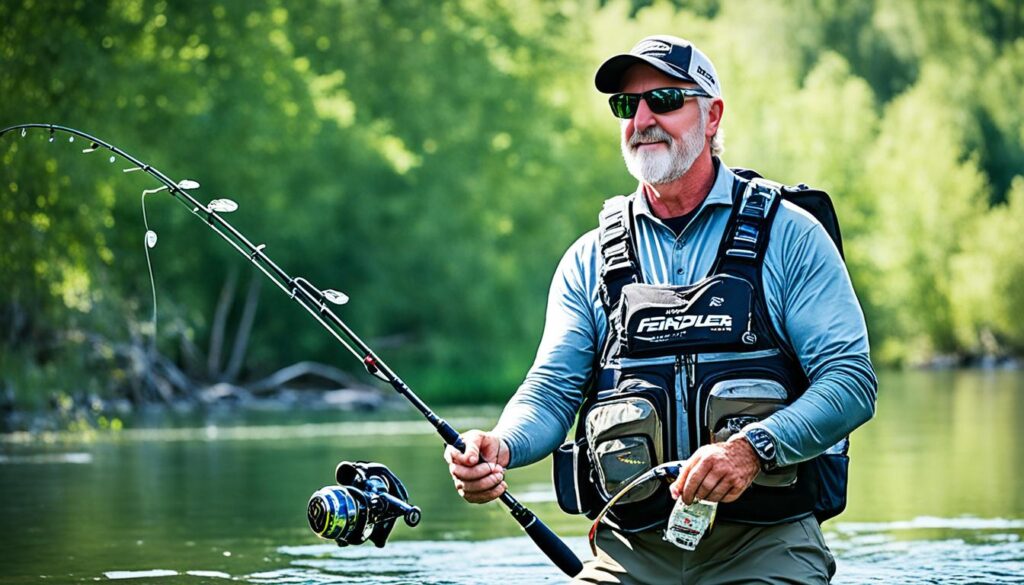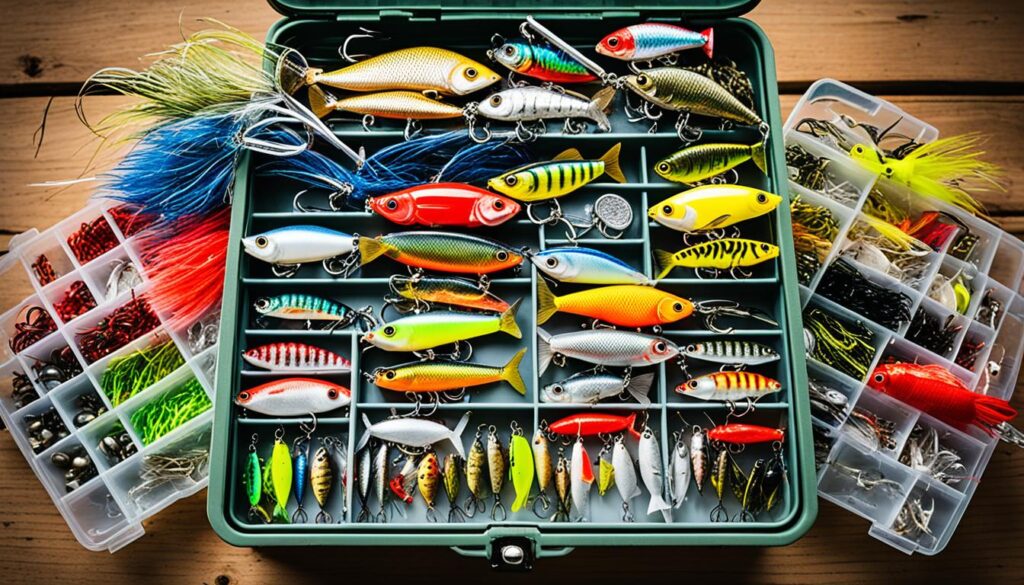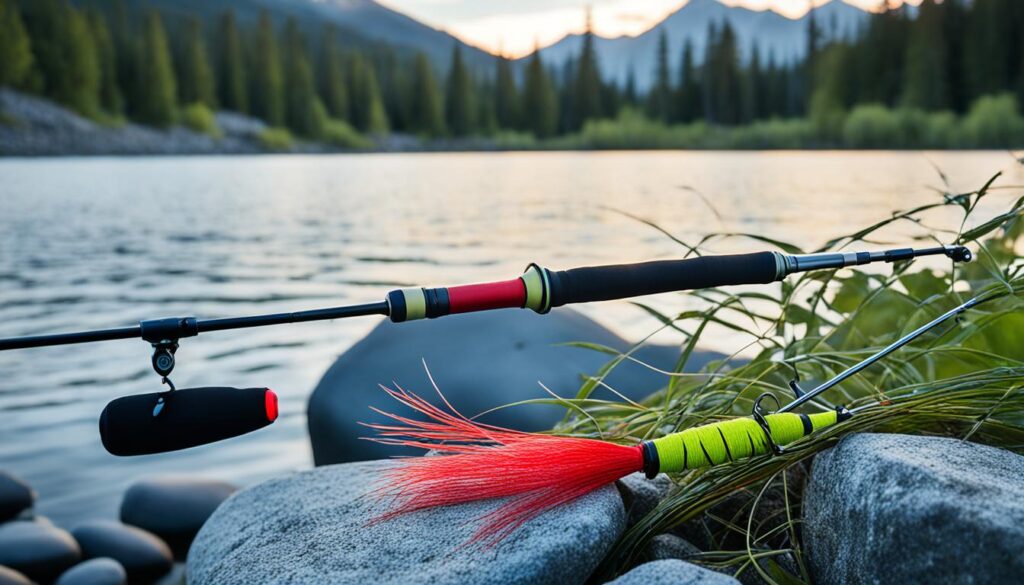Are you ready to take your bass fishing game to the next level? Then it’s time to unlock the secrets of bed fishing for spawning bass. During the months of March and April, bass expert Gerald Swindle reveals that a significant number of bass are in the spawning stage. By understanding their behavior and using the right techniques and baits, you can increase your chances of catching more spawning bass and experience the thrill of a successful bed fishing adventure.
Key Takeaways
- During the spawning stage, bass exhibit territorial behavior and can be caught with the right approach.
- Understanding the bass’s behavior, such as reading their mood and paying attention to their level of interest in protecting the nest, is crucial for successful bed fishing.
- Using the best baits, such as plastic lizards and finesse presentations, can greatly enhance your chances of enticing a bite from bedding bass.
- When engaging in bed fishing for spawning bass, it’s important to consider the ethical aspects of the practice and handle the fish with care for conservation purposes.
- Knowing where to find bedding bass, such as in shallow coves and protected flats, can help you target the right areas for your fishing endeavors.
Understanding Spawning Bass Behavior
Success in bed fishing for bass relies on understanding their behavior during the spawning process. Bass are highly territorial, especially when they have eggs laid. The male bass, also known as the buck bass, does most of the work in guarding the nest. It is important to pay attention to the bass’s return to the bed and observe if it shows a strong interest in protecting the nest. Bass beds can vary in size, and targeting a specific hot spot on the bed can increase the chances of catching bedding bass.
During the spawning season, bass behavior becomes crucial to catching catchable bass. With their eggs laid, bass become highly territorial, making them more responsive to fishing techniques. In particular, the male bass, also referred to as the buck bass, takes on the responsibility of guarding the nest. Observing the bass’s return to the bed and their level of involvement in protecting the nest can provide valuable insights into their mood and willingness to bite. By identifying the hot spots on the bed, anglers can strategically position their lures for optimum results.
“Understanding the behavior of spawning bass is key to successfully catching them. By paying close attention to their return to the bed and their level of interest in protecting the nest, anglers can increase their chances of hooking up with bedding bass.”
– Gerald Swindle, Bass Fishing Expert
In addition to territorial behavior, bass beds can vary in size and overall structure. Some beds may be larger, consisting of multiple areas where bass may position themselves. Others might be smaller and more concentrated. Identifying these hot spots on the bed is crucial to effectively target catchable bass. By understanding the behavior of spawning bass, anglers can adapt their fishing techniques and tactics to read the bass’s mood and increase their success in bed fishing.
| Key Points | Benefits |
|---|---|
| Understanding bass behavior | Increased chances of catching spawning bass |
| Observing bass’s return to the bed | Insights into bass mood and receptiveness to lures |
| Identifying hot spots on the bed | Targeting catchable bass more effectively |
Best Baits for Bed Fishing Bass
When it comes to bed fishing for bass, using the right bait can make all the difference. Bass fishing pro Gerald Swindle recommends a tried and tested lure that has proven successful in catching bedding bass – the plastic lizard. During the spring, lizards are particularly active and feed on bass eggs, which makes them a direct threat to the nesting bass. By using a plastic lizard, you can imitate these predatory intruders and trigger a territorial response from the bass.
If the bass are not showing interest in the plastic lizard, it’s important to switch things up. Downsizing to a smaller bait, such as a compact craw, can sometimes do the trick. The compact craw can mimic smaller threats to the bass eggs and entice a bite from the bedding bass.
Recommended Baits for Bed Fishing
| Bait | Description |
|---|---|
| Plastic Lizard | Mimics predatory threats to bass eggs |
| Compact Craw | Resembles smaller threats to bass eggs |
Additionally, finesse presentations can be highly effective when bass are being particularly finicky. Consider using a wacky rig or a drop shot setup to entice strikes from the stubborn bedding bass. These finesse presentations offer a subtle and natural presentation that can be irresistible to bass in their spawning mood.
Remember, every bass is unique and may respond differently to various baits. To maximize your chances of success, don’t be afraid to experiment with different baits and find the one that matches the fish’s mood. The key is to be patient, observant, and adaptable to increase your success in bed fishing for bass.
The Ethics of Bed Fishing for Spawning Bass

While bed fishing for spawning bass can be an exciting and productive technique, it’s essential to consider the ethics of fishing during the spawning season. As anglers, we have a responsibility to practice conservation and handle spawning bass with care to protect their populations for future generations.
Bass expert Gerald Swindle emphasizes the importance of handling spawning bass with both speed and care. After catching a bedded bass, it’s vital to release it immediately back to the same spot. This ensures the bass can continue their spawning process without unnecessary stress or harm.
Understanding the biology of largemouth bass is crucial in making informed decisions about bed fishing and conservation. During the spring, when most shallow bass are at some stage of the spawn, it’s essential to prioritize their well-being. By respecting their natural behaviors and habitats, we contribute to the long-term sustainability of bass populations.
Conservation efforts play a significant role in protecting spawning bass and their vulnerable eggs. By practicing catch-and-release, we allow the bass to complete their spawning process and contribute to the next generation. Additionally, minimizing the time spent out of the water and handling the fish gently can help protect the eggs from predation and ensure successful reproduction.
As responsible anglers, we can make a difference in the preservation of bass populations and their habitats. By prioritizing the ethical aspects of bed fishing, we contribute to the conservation of these incredible fish and the overall health of our ecosystems.
The Importance of Conservation
“Conservation is a lifelong commitment, and every angler should play their part in preserving fish populations and their habitats.” – Gerald Swindle
Conservation is not only about the individual actions we take as anglers but also about promoting awareness and advocating for responsible fishing practices. Here are some key reasons why conservation is vital:
- Sustainable Fish Populations: By conserving bass populations and their spawning habitats, we ensure the long-term sustainability of the fishery and maintain healthy fish populations for future generations.
- Ecosystem Balance: Largemouth bass play an essential role in maintaining the balance and health of aquatic ecosystems. Protecting their habitats and allowing them to fulfill their spawning process helps preserve the natural balance of these ecosystems.
- Preservation of Biodiversity: Bass populations are part of a diverse ecosystem that includes various species of fish, plants, and other wildlife. By conserving bass populations, we contribute to the preservation of overall biodiversity in our waters.
- Personal Responsibility: As anglers, it is our responsibility to ensure the well-being of the fish we pursue. Engaging in ethical fishing practices and promoting conservation helps us fulfill our role as stewards of the environment.
Conservation is a collaborative effort that involves both individual actions and collective awareness. By adopting ethical fishing practices, practicing catch-and-release, and supporting conservation organizations, we can contribute to the preservation of bass populations and their spawning habitats.
Where to Find Bedding Bass
Largemouth bass prefer spawning in shallow, protected areas such as coves and flats. These locations offer the ideal conditions for their nesting activities.
Bass tend to avoid strong currents, windy areas, and places with high boat traffic when selecting their spawning sites.
When searching for bedding bass, it’s beneficial to explore creek channels that have nearby flats and some form of cover, like timber or rock formations. These features increase the chances of finding bass actively engaged in the spawning process.
Understanding the factors that influence bass spawning behavior, such as water temperature, can further assist anglers in locating productive areas for successful bed fishing.
| Factors for Finding Bedding Bass | Examples |
|---|---|
| Shallow coves and flats | Protected bays, inlets, and shallow areas with healthy vegetation |
| Away from strong currents | Protected pockets, calm areas shielded by natural barriers |
| Away from wind | Sheltered coves, leeward sides of islands, wind-protected areas |
| Away from boat traffic | Quiet backwaters, secluded locations away from heavy motorized activity |
How to Catch Bedding Bass – Tactics and Techniques

Catching bedding bass requires specific tactics and techniques. Accurate casting is crucial, with the line draped over the fish’s nose and the rod tip held high to manage the line at the correct angle. Hopping the bait using an unpegged Texas-rigged creature bait can trigger a reaction from the bass. It’s important to place the bait past the fish and hop it towards the mouth to entice a bite. The best time to catch bedding bass is when the males make beds and the females have yet to lay eggs. Patience and persistence are key in bed fishing for bass.
Tactics for Accurate Casting
When targeting bedding bass, accurate casting is essential to place your bait precisely where it needs to be. Follow these tactics for accurate casting:
- Position yourself at a distance that allows for a targeted cast towards the bed.
- Keep your line slack-free and hold your rod tip high to manage the line and guide your bait accurately.
- With a smooth, controlled motion, cast your bait past the fish and bring it towards the bed slowly.
- Pay attention to the fish’s reaction and adjust your casting technique accordingly.
Hopping the Bait Technique
Hopping the bait is a proven technique to trigger strikes from bedding bass. Here’s how to effectively hop your bait:
- Select an unpegged Texas-rigged creature bait, such as a soft plastic lizard or crawfish imitation.
- Place your bait past the fish and let it settle near the bed.
- With a slight upward motion, hop your bait towards the fish’s mouth, imitating natural movement.
- Allow your bait to fall back to the bottom and repeat the hopping motion.
- Vary the speed and intensity of your hops to entice a reaction from the bass.
“Accurate casting and strategic bait movement are essential when targeting bedding bass.” – Bass Fishing Pro
The Timing for Bedding Bass
Timing is crucial when it comes to bed fishing for bass. To maximize your chances of success, focus on the following timing factors:
- Target male bass when they are actively making and guarding beds.
- Avoid fishing for bedding bass once the females have laid their eggs, as they become less interested in biting.
- Monitor local water temperatures, as warmer temperatures can accelerate the spawning process and increase bass activity.
By applying these tactics and techniques, you’ll increase your chances of successfully catching bedding bass. Remember to be patient, observe the fish’s behavior, and adapt your approach accordingly. Happy bed fishing!
Recommended Baits and Colors for Bed Fishing

When bed fishing for bass, using the right baits and colors can significantly increase your chances of success. After years of experience and countless hours on the water, I have found that certain baits consistently produce results.
Senko Baits
One of my go-to baits for bed fishing is the wacky rigged Senko. Its subtle action and realistic appearance make it irresistible to bass, particularly during the spring spawning season. Whether you choose a natural color or a vibrant one, Senkos are deadly all year round.
Lizard Baits
Another effective bait for bed fishing is the lizard. Lizards are known to be threats to bass eggs, triggering a protective response from the bedding bass. Opt for a soft plastic lizard imitation in natural colors like green or brown. Present it near the bass’s nest, and you’re likely to entice a strike.
Crawfish Imitations
Crawfish are a natural prey for bass, and using soft plastic crawfish imitations can mimic a threat to their eggs. These baits can be highly effective in triggering a reaction from bedding bass. Experiment with different sizes and colors to find the right combination that appeals to the bass in your local waters.
Color Recommendations
While the effectiveness of colors can vary depending on various factors, there are a few colors that are widely recommended for bed fishing. Starting with white, bubblegum, and green pumpkin is a good idea as they offer high visibility underwater and can attract the attention of bedding bass.
Remember, fishing success depends on various factors such as water conditions and bass behavior, so it’s essential to experiment with different baits and colors to find what works best in your specific fishing location.
Handling Bedded Bass and Conservation
During the spawn, bedded bass and their eggs are vulnerable to predation. It is crucial to handle these bass with care to protect their survival and contribute to the well-being of future fish populations. As an angler, I understand the importance of releasing bedded bass back to their beds quickly and without causing unnecessary stress.
When catching bedded bass, it’s essential to minimize the time they are out of the water. By taking quick photos and promptly releasing them, we can help protect the vulnerable eggs and ensure the bass can return to guarding their nests. This practice plays a significant role in the conservation efforts of our beloved bass species.
By practicing responsible handling and releasing, we can contribute to the conservation of bedded bass and safeguard the future of the sport. The well-being and survival of the eggs are crucial for maintaining healthy fish populations and ensuring a thriving ecosystem.
Conclusion
After exploring the various aspects of bed fishing for spawning bass, it is clear that this technique requires a combination of skill, knowledge, and ethical considerations. Understanding bass behavior, such as their territorial nature and nesting habits, is crucial in determining their location and increasing the chances of success.
Accurate casting and the use of effective baits, such as plastic lizards and finesse presentations, can entice bedding bass to strike. Experimenting with different baits and colors, such as wacky rigged Senkos and soft plastic crawfish imitations, allows anglers to adapt to the fish’s preferences and increase their chances of a bite.
However, it is essential to approach bed fishing with a mindset of conservation and proper handling of the fish. Releasing bedded bass quickly and minimizing stress on them and their vulnerable eggs helps maintain the fish population and preserve the future of this beloved sport.
By following the bed fishing techniques, spawning bass strategies, and ethical principles discussed in this article, anglers can elevate their fishing experiences, improve their success in catching spawning bass, and contribute to the preservation of the bass population for generations to come.
FAQ
What is bed fishing for bass?
Bed fishing for bass involves targeting bass that are in the spawning stage. During this time, bass create nests or beds to lay and protect their eggs. Anglers use specific techniques and baits to catch these spawning bass.
Are all bedding bass catchable?
According to bass fishing expert Gerald Swindle, all bedding bass are catchable. However, the time it takes to get a bite can vary. It’s important to pay attention to the bass’s behavior and read their mood in order to be successful in bed fishing.
How can I determine if a bass is guarding a nest?
To determine if a bass is guarding a nest, observe its behavior. Look for signs of aggression and strong interest in protecting a specific spot. Bass beds can vary in size, so targeting a specific hot spot on the bed can increase your chances of catching bedding bass.
What are the best baits for bed fishing bass?
Bass fishing pro Gerald Swindle recommends using a plastic lizard as one of the best lures for bed fishing. Lizards are active during the spring and often feed on bass eggs, making them a threat to the bedding bass. If the bass are not responding to a lizard, downsizing to a smaller bait like a compact craw can be effective. Finesse presentations such as a wacky rig or drop shot can also be used if the bass are being finicky.
Is bed fishing during the spawning season ethical?
It is important to consider the ethical aspects of bed fishing during the spawning season. Bass expert Gerald Swindle emphasizes the need to handle spawning bass with care and speed and immediately release them to the same spot. Understanding the biology of largemouth bass and the fact that most shallow bass are at some stage of the spawn during the spring can help anglers make informed decisions about bed fishing and conservation.
Where do bass typically spawn?
Largemouth bass prefer shallow protected coves and flats to build their nests. These areas provide them with the ideal conditions for spawning. Bass will often choose areas away from strong current, wind, and boat traffic. Finding creek channels with nearby flats and some form of cover such as timber or rock can increase the chances of finding bedding bass.
What are the tactics and techniques for catching bedding bass?
Catching bedding bass requires specific tactics and techniques. Accurate casting is crucial, placing the line draped over the fish’s nose and holding the rod tip high to manage the line at the correct angle. Hopping the bait using an unpegged Texas-rigged creature bait can trigger a reaction from the bass. It’s important to place the bait past the fish and hop it towards the mouth to entice a bite. The best time to catch bedding bass is when the males make beds and the females have yet to lay eggs. Patience and persistence are key in bed fishing for bass.
What are the recommended baits and colors for bed fishing?
Wacky rigged Senkos are deadly throughout the year, but particularly in the spring for bed fishing. Lizards and soft plastic crawfish imitations are also great options for mimicking threats to bass eggs. It’s important to experiment with different baits and colors to find what the bass are responding to. White, bubblegum, and green pumpkin are recommended colors to start with, as they are easily visible underwater.
How should I handle bedded bass for conservation?
During the spawn, bedded bass and their eggs are vulnerable to predation. It is important to handle bedded bass with care to ensure their survival and the success of future fish populations. Anglers should quickly release bedded bass back to their beds after catching them and avoid causing unnecessary stress. Taking quick photos and minimizing the time out of the water can help protect the eggs and contribute to conservation efforts.
How can I catch more spawning bass?
To catch more spawning bass, it is essential to understand their behavior, use the right techniques and baits, and handle them with care. By following the tips and techniques discussed in this article, anglers can improve their chances of catching more spawning bass and elevate their bass fishing strategies. Patience, persistence, and proper handling of bedded bass contribute to a successful and sustainable bed fishing experience.
